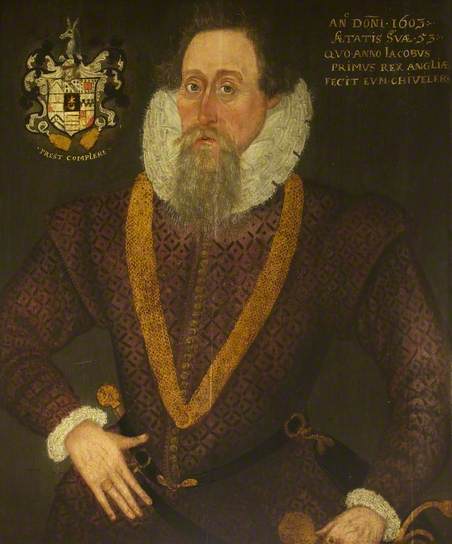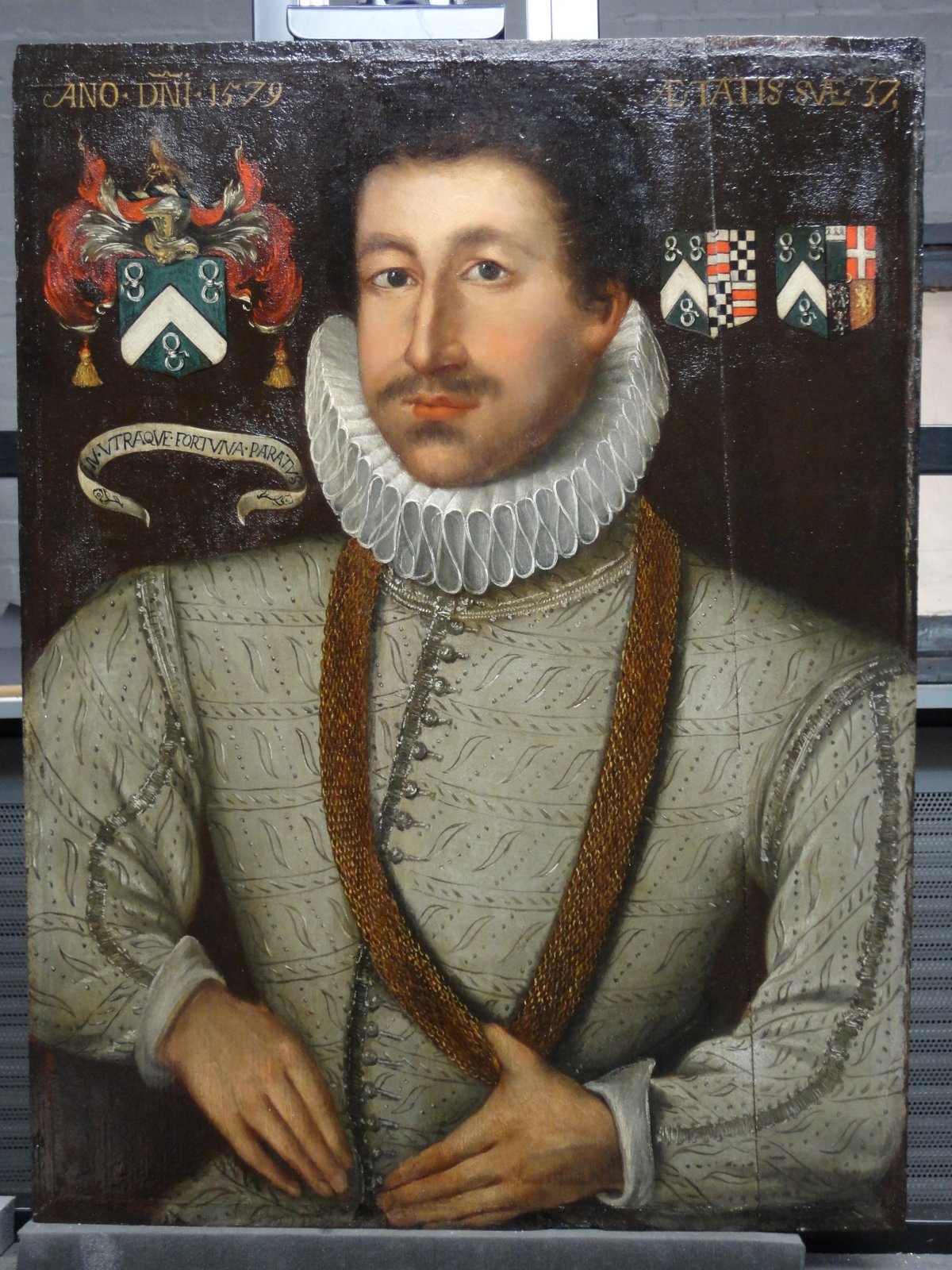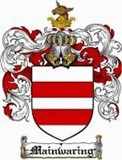Sir Arthur Mainwaring and Margaret Mainwaring
Sir Arthur Mainwaring was born about 1520 in Ightfield, Shropshire, England to Sir Richard Mainwaring and Dorothy Corbet. He was educated at Gray's Inn (one of the Inns of Court) in 1542. Sir Arthur married Margaret Mainwaring. Margaret was born about 1521 to Sir Randall Mainwaring and Elizabeth Brereton and was of Over Peover, Cheshire, England.
Sir Arthur and Margaret were distant relatives. Sir Arthur's great-great-grandfather, the founder of the Mainwarings of Ightfield, William Mainwaring was the brother of Margaret's great-great-great-grandfather, John Mainwaring of Over Peover, and William and John were sons of Randle Mainwaring of Over Peover.
Sir Arthur served at Berwick-upon-Tweed, Northumberland, England under John Dudley, Earl of Warwick (Lieutenant of the King's Army). He was knighted there in October 1547 by the earl. Boyer believed that he had been "probably engaged in the the campaign which led to the Battle of Pinkie" at that time. This campaign, later named The Rough Wooing, was part of a war between England and Scotland that was partly an effort to break the "Auld Alliance" (between Scotland and France). The campaign was also partly due to the renouncing by the Scots of the conditionally-accepted Treaty of Greenwich, which included a marriage between the future Edward VI and the infant Mary Queen of Scots. The renunciation incurred the wrath of Henry VIII, who then attempted to force the marriage alliance on the Scots. Hostilities began with an attack on Edinburgh and English troops burned town and villages as they went. The campaign ended with a decisive English victory at the Battle of Pinkie but the Scots still refused to give in to English demands (instead, Mary was taken to France, where she was betrothed to the French dauphin). During the last year of Queen Mary I's reign (about 1558), he was in charge of 200 men from Shropshire during a campaign against Scotland. In May 1560, he took part in the Siege of Leith.
According to the History of Parliament, he "was a considerable landowner" who inherited "extensive estates" from his father-in-law in Cheshire (in Bradley, Stretton, etc. and houses in Chester). He also owned land in Shropshire (manor of Ightfield, a house at Coton, lands in Steele, Whitchurch, and Whixhall). Sir Arthur was a member of Parliament for Shropshire in 1558. He was also the Commissioner of the Peace in 1561/2 and Sheriff in 1562-3 and 1576-7, and a member of the Royal Commission of Musters (to ensure that all men in Shropshire from 16-60 were armed, trained, and inspected) in 1577. In regards to religion, he was classified in 1564 by the Bishop of Chester "as favourable to the established church."
Sir Arthur died 2 September 1590, having written his will that same day. He was buried 4 September 1590 in Ightfield, Shropshire, England and his will was proved 21 June 1591. Margaret was not mentioned in his will, so she had probably predeceased him.
Sir Arthur and Margaretís children are:
- Elizabeth Mainwaring, married Sir Thomas Aston (of Aston, Cheshire, England, son of John and Margaret (Ireland) Aston, Sheriff of Cheshire 1601, knighted 1603, m. 2) Mary Unton, d. 1613), died 9 Aug 1606, buried in Runcorn, Cheshire, England.
- Margeria Mainwaring, also called Margery.
- George Mainwaring, educated at Shrewsbury School in 1562, married Anna More (dau. of William More of Loseley, Surrey), barrister at the Inner Temple in 1565, Sheriff of Shropshire in 1572, knighted in 1595, died intestate 5 May 1628 in Ightfield, Shropshire, England.
- Mary Mainwaring, married Sir Richard Cotton (b. abt. 1539, son of Sir George and Mary (Onley) Cotton, built the manor house at Combermere Abbey in 1563, m. 2) Jane Seyliard and 3) Philippa ó, d. intestate 14 Jun 1602 in Stoke, Warwickshire, England) 6 January 1559/60 in Combermere, Shropshire, England.
Sources:
Records related to Sir Arthur and Margaret (Mainwaring) Mainwaring but not copied below due to copyright considerations:
- Stewart-Brown, R. (ed.), Cheshire Inquisitions Post Mortem: Stuart Period, 1603-1660,Vol. I (A-D), The Record Society of Lancashire and Cheshire, 1934, p. 146.
- Letters from Sir Arthur Mainwaring to Sir William More, The National Archives, viewed 24 June 2017:
- http://discovery.nationalarchives.gov.uk/details/r/46184730-d0f2-4e49-9463-27fd56010429
- http://discovery.nationalarchives.gov.uk/details/r/678cb0fc-218d-44dd-8fe4-35a126f80742
- Burke, John, A Genealogical and Heraldic History of the Extinct and Dormant Baronetcies of England, London: Scott Webster and Geary, 1838, p. 25.
- Ancestry.com. Cheshire, England, Extracted Church of England Parish Records [database on-line]. Provo, UT, USA: Ancestry.com Operations Inc, 2001.
- Boyer, Carl, Medieval English Ancestors of Robert Abell, Santa Clarita, CA: C. Boyer, 2001.
- Entry for MAINWARING, Sir Arthur (c.1525-90), of Ightfield, Salop., The History of Parliament, http://www.historyofparliamentonline.org/volume/1558-1603/member/mainwaring-sir-arthur-1525-90, retrieved 24 Jun 2017, originally published in The History of Parliament: the House of Commons 1558-1603, ed. P.W. Hasler, 1981.
- Entry for MAINWARING, George (bef.1551-1628), of Ightfield, Salop., The History of Parliament, http://www.historyofparliamentonline.org/volume/1558-1603/member/mainwaring-george-1551-1628, retrieved 24 Jun 2017, originally published in The History of Parliament: the House of Commons 1558-1603, ed. P.W. Hasler, 1981.
Portraits and Other Images
Sir Thomas Aston (exhibited at Snowshill Manor, Gloucestershire):
Portraits from Combermere Abbey site (http://www.combermere-restoration.co.uk/1500s-to-present-day/):
Description: "Richard Cotton; the portrait inset into the fire surround in The Library"
Mainwaring Arms:
Church Records
Text: Dame Elizabeth Aston, late wiffe to Sr Thomas Aston of Aston, in the County of Chester, Knight, dyed on 09 Aug 1606 , and lyeth interred in Runcorne Church, in the
Book: Marton Marriages. Addenda Et Corrigenda. (Marriage)
Collection: Cheshire and Lancashire: - Funeral Certificates, 1600-1678
Source: Ancestry.com. Cheshire, England, Extracted Church of England Parish Records [database on-line]. Provo, UT, USA: Ancestry.com Operations Inc, 2001.
Letters
Reference: 6729/7/127
Title: Letter from Sir Arthur Mainwaring, Ightfield [Salop], to his 'brother-in-law' Sir William More, Loseley. More's letter has caused Mainwaring to 'receive better hope of your liking of this match of marriage'. He knows More would have allowed his daughter to refuse his son [George] and is pleased that the latter stayed longer at More's own request. He urges that their children should understand 'that you and I be entered into this firm league that who shall please the one of us has to please both and contrarywise'. He thanks More for his invitation to Loseley and hopes to 'entice you to this rude and barbarous soil'. He asks More to send him his 'coat of arms with the crest in colours'. Dated 5 Apr. [HMC p.662b where it is dated Sep; see also LM/COR/3/612; Anne More married Sir George Mainwaring; their eldest son Arthur was born in 1582]
Date: nd [1576 x 1582]
Held by: Surrey History Centre, not available at The National Archives
(See: http://discovery.nationalarchives.gov.uk/details/r/46184730-d0f2-4e49-9463-27fd56010429)
Reference: 6729/7/34
Title: Letter from Sir Arthur Mainwaring, Ightfield, Salop, to his 'brother in law' Sir William More. He thanks him for his 'courteous' letter and gives warm acknowledgement of the mutual friendship between them and their families. He commends himself to Lady More [d.1587]. Dated 5 Jun. [HMC p.662a]
Date: nd [1576 x 1587]
Held by: Surrey History Centre, not available at The National Archives
(See: http://discovery.nationalarchives.gov.uk/details/r/678cb0fc-218d-44dd-8fe4-35a126f80742)
Source: Letters from Sir Arthur Mainwaring to Sir William More, The National Archives, viewed 24 June 2017.
Inquisition Post Mortem
(File 87. No. 14).
They say the said Richard Cotton the day he died was seised in fee of a capital mess. in Cumbermeyre & of a water mill, 1000 a. of land, 500 a. of meadow, 1000 a. of pasture, 200 a. of moor, 200 a. of wood & 200 a. of land covered with water in Combermeyre, Wrenbury & Aldelem.
He was also seised in fee tail, to him & his male issue, of the manor of Wilkesley.
The said capital mess. & lands are held of the King & at the time of Richard's death of Queen Elizabeth in chief, by 10th part of a knight's fee & rent of 53s. 4d. a year & worth yearly (clear) £12.
The manor of Wilkesley held in like manner, by 20th part of a knight's fee & yearly rent of £4 12s. 8d. & worth yearly (clear), £56.
The said Richard died 15 June 44 Elizabeth [1602] & George Cotton, esq. is his son & next heir & now aged 40 years & more & since his father's death has occupied the said premises.
Source: Stewart-Brown, R. (ed.), Cheshire Inquisitions Post Mortem: Stuart Period, 1603-1660,Vol. I (A-D), The Record Society of Lancashire and Cheshire, 1934, p. 146.
Burke's Extinct and Dormant Baronetcies of England
SIR THOMAS ASTON, of Aston, who received the honour of knighthood in 1603. He m. first, in 1569, Elizabeth, daughter of Sir Arthur Mainwaring, of Ightfield, and had issue,
John, his successor.He wedded, secondly, Mary, daughter of William Unton, esq. of Dracton, in Salop, but had no other issue. She survived him, and m. secondly Edward Payler, esq. of York. Sir Thomas was sheriff of Cheshire in 1601. He d. in 1613, and was s. by his eldest son,
Arthur (Sir), of Fulham, in Middlesex, who had two sons, Richard Aston, and SIR ARTHUR ASTON, a colonel in the army, and governor of Oxford for the king in 1644, who was put to death by the rebels at Tredagh, in Ireland, in 1655, after having surrendered the town on conditions. He left issue.
Thomas (Sir), m. Elizabeth, daughter of John Shuckburgh, esq. of Birdenbury, in Warwickshire, and had issue.
Frances, m. first, to John Hocknell, esq. of Hocknell; secondly, to Robert Davis, of Croughton; and thirdly, to Owen Longford, of Burton, in Derbyshire.
Grace, d. s. p.
Margaret, m. to Sir Thomas Ireland, of Beusy, near Warrington, and was vice chamberlain of Chester .
Elizabeth, m. to Richard Dod, esq. of Cloverley in Shropshire.
Mary, m. first to Richard Brown, gent. of Upton, near Chester; and secondly, to Jaques Arnodio.
Anne, m. to Richard Allen, esq. of Greenhill, Cheshire.
Catherine, m. to Peter Leigh, gent. of Ridge.
JOHN ASTON, esq. of Aston, sewer to ANNE, Queen Consort of King JAMES I. This gentleman m. in 1611, Maude, daughter of Robert Needham, esq. of Shenton, in Shropshire, and had three sons and three daughters...
Source: Burke, John, A Genealogical and Heraldic History of the Extinct and Dormant Baronetcies of England, London: Scott Webster and Geary, 1838, p. 25.


